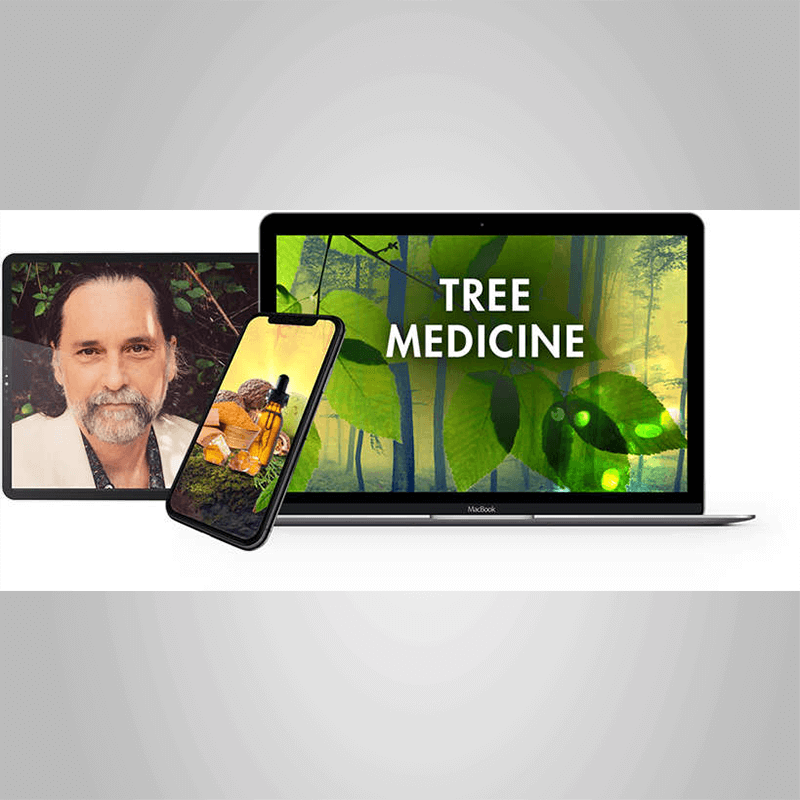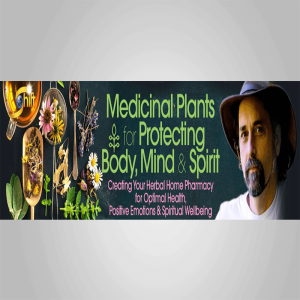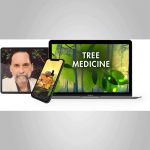David Crow – Tree MedicineModule 1: Tree Medicines for Healing the Spirit & Deepening Peace of Mind (May 13)Healing the spirit means many things — including alleviating grief, resolving past trauma, and giving intuitive insight to guide us through difficulties.Cultivating and deepening peace of mind is a necessity in challenging times.In this opening module, David will explain how modern research now confirms what almost everyone already knows from personal experience — that spending time in forests is therapeutic for the body and mind.The simple presence of the trees, their beauty, the peace they create in their environment, their age, and their wisdom are all part of their healing powers.But trees are not just a source of solace and refuge, beauty and protection; they are also the origin of numerous important medicines that have been used since time immemorial for their mood-uplifting and mind-calming properties.Some of these medicines have a long history of use as incense for purification, some can be used in aromatic baths, some are made into teas and tinctures for anxiolytic (anti-anxiety) functions — and all are pleasing to the senses, nourishing to the heart, and supportive of our spiritual growth.In this module, you’ll discover:An introduction to the healing power of treesSacred temple incenses and aromatic “wish-fulfilling gems†for prayer, meditation, ceremonial offerings — and creating magical synchronicitiesThe blessings of sandalwood and agarwoodThe history and uses of the many types of copalLinden, albizia, and other tree flowers that promote happinessCedar, juniper, and other conifers used for spiritual protection around the worldModule 2: Tree Medicines for Immune Protection, Atmospheric Purification & Respiratory Health (May 20)There is a direct anatomical and physiological relationship between the human respiratory system and trees: the lungs are a mirror image of trees’ structure, and we are breathing with them in an opposite gaseous exchange.As David will explain this week, it’s only natural that many of the compounds that trees produce for their own immunity are major medicines for respiratory conditions.Essential oils distilled from the needles of conifers and leaves of eucalypti purify the atmosphere and protect the lungs; spices from trees strengthen immunity both as herbs and as oils; flowers and fruits from trees such as elderberry are famous for their immune-boosting powers.Trees offer many medicines from their barks and roots that restore and regenerate respiratory functions, and also give resins that bees make into propolis, a powerful natural antimicrobial remedy.In this module, you’ll explore:Tree flowers and fruits for respiratory immunityAromatic salves, steam treatments, and herbal baths with tree medicines for the lungsTree spices and their essential oils for antimicrobial protectionConifer and eucalyptus essential oil preparations for respiratory healthPropolis: bee medicine from tree resinsWild cherry bark, loquats, and other tree medicines for coughs and congestionMulberry leaves, plum paste, apricot seeds, and other ingredients of traditional Chinese formulas for respiratory conditionsModule 3: Tree Medicines for Digestive Health & Dental Hygiene (May 27)Tree medicines have been used since antiquity for supporting digestive health and treating digestive ailments.This week, David will share spices from trees that have well-known benefits for improving the appetite and protecting gut immunity.Many tree species are used in different forms for their antimicrobial and antiparasitic powers — and numerous tree medicines are beneficial and effective for dental hygiene purposes.Some of the traditional herbal formulas from Chinese and Ayurvedic medicine that are now widely available are tree medicines — including Triphala, the “three fruits,†which are a complete pharmacy for countless digestive problems.In this module, you’ll explore:Neem and arak — antimicrobial tooth sticks for dental hygieneTree spices for enhancing digestive powerSlippery elm, black walnut, white oak — and other tree medicines for restoring gut mucosaAyurveda’s 3 tree fruits for regulating digestion and eliminationMastic gum and other resins for digestive infectionsPapaya, hawthorn, and other fruits that stimulate digestionMagnolia bark and other tree remedies for digestive stagnationPomegranate, white oak, and other tree medicines for digestive infections and parasitesModule 4: Tree Medicines for the Heart & Circulation (June 3)Trees offer many medicines that are beneficial for the cardiovascular system — in diverse forms such as leaves, bark, fruits, and resins.This week, David will share how sometimes the medicines used for human purposes were produced by trees for the same purposes — such as resins, the blood of trees, being used for circulatory conditions.Some tree medicines have been used for these purposes for centuries or longer, while others are more recent additions to the pharmacopeia. Tree medicines in this category can be used for treating cardiac insufficiency, enhancing cerebral circulation to support cognitive functions, lowering cholesterol and regulating blood pressure, improving vein health, and many other similar purposes.In this module, you’ll explore:The powers and uses of ginkgoHawthorn, arjuna, and other tree medicines for strengthening the heart and cardiovascular systemTree medicines for vein healthFrankincense, myrrh, and other resins — including the “blood†of trees for circulatory benefitsTree oils and herbal baths for improving circulationGuggulu: Ayuvedic tree medicine for the cardiovascular and musculoskeletal systemsModule 5: Tree Medicines for Removing Pain & Inflammation (June 10)Numerous tree medicines have significant anti-inflammatory and analgesic powers that can be helpful for both acute and chronic conditions.As David will explain this week, some are in the form of essential oils that can be prepared into liniments, some are best taken as tinctures and teas, and some can be used in herbal baths.Tree medicines in various forms are used for treating inflammation in the digestive tract, dysmenorrhea, musculoskeletal pain and inflammation, headaches, and many other conditions.These medicines are often milder than their modern synthetic counterparts — but work at a deeper level of healing and with far fewer side effects and adverse reactions.In this module, you’ll explore:The anti-inflammatory powers of frankincense, myrrh, and other tree resinsJamaican dogwood, white willow bark, and other tree-based analgesic remediesBlackhaw and other antispasmodic tree medicinesConifer and eucalyptus leaves and their essential oils for pain and inflammationEucommia bark for strengthening the musculoskeletal systemDemulcent tree medicines for soothing digestive inflammationCinnamon, myrrh, melia, and other pain-relieving herbs used in Chinese medicineModule 6: Tree Medicines for Detoxification (June 17)Detoxification is an important aspect of healing. It requires specific knowledge of what, when, where, and how to get the best results.This week, David will share numerous tree medicines that gently support the body’s natural detoxification processes. You’ll also explore other tree medicines that are stronger purgatives and purifiers.Some work by assisting the cleansing of the blood, some work by enhancing lymphatic drainage, some work by improving digestive power and restoring the gut membrane and microbiome, and some work by supporting liver and kidney functions.In this module, you’ll discover:Haritaki, the Medicine Buddha’s supreme healing fruitCeanothus, sarsaparilla, and other trees for purifying the liver, blood, and lymphNeem tree, the village pharmacy — and its powers of neem bark, seeds, oil, and leavesTree spices for digestive detox and microbial protectionBlack walnut, prickly ash bark, triphala, and other tree medicines for restoring digestive healthJuniper berries and other tree medicines for the urinary systemCascara and other tree medicines for laxative purposesModule 7: Tree Medicines for Infections, Wounds & Skin Conditions (June 24)Tree medicines have been used by cultures around the world for millennia to treat infections, wounds, and skin conditions.As David will share in this closing week, widely used tree medicines now include tea tree oil — while others, such as the usnea lichen that grows on trees, are less well-known.Some trees give multiple forms of medicine — such as the olive, which gives food, oil that can be used for herbal preparations, and the leaves that have documented antimicrobial and anti-inflammatory powers.In this final module, you’ll explore:The healing powers of the olive treeUsnea, antimicrobial tree lichenThe alkaloid medicines of the mahonia and berberis speciesYew tips, poplar buds, and other traditional tree medicines for wounds and infectionsDragon’s blood and copaiba — Amazonian tree medicines for healing the skinTea tree, manuka, niaouli, and other potent antimicrobial essential oilsSpruce pitch, poplar buds, and other tree medicines for the skinPhilodendron, neem, and other tree barks for treating infections








